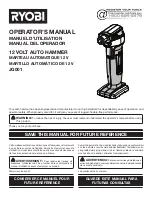
4
ENGLISH
(Original instructions)
5
ENGLISH
(Original instructions)
capabilities, or lack of experience and knowledge, unless
they have been given supervision or instruction concern-
ing use of the appliance by a person responsible for their
safety.
u
Children should be supervised to ensure that they do not
play with the appliance.
Residual risks.
Additional residual risks may arise when using the tool which
may not be included in the enclosed safety warnings. These
risks can arise from misuse, prolonged use etc.
Even with the application of the relevant safety regulations
and the implementation of safety devices, certain residual
risks can not be avoided. These include:
u
Injuries caused by touching any rotating/moving parts.
u
Injuries caused when changing any parts, blades or ac-
cessories.
u
Injuries caused by prolonged use of a tool. When using
any tool for prolonged periods ensure you take regular
breaks.
u
Impairment of hearing.
u
Health hazards caused by breathing dust developed when
using your tool (example:- working with wood, especially
oak, beech and MDF.)
Labels on tool
The following pictograms are shown on the tool along with the
date code:
:
Warning!
To reduce the risk of injury, the user must
read the instruction manual.
Electrical safety
#
This tool is double insulated; therefore no earth wire
is required. Always check that the power supply
corresponds to the voltage on the rating plate.
u
If the supply cord is damaged, it must be replaced by the
manufacturer or an authorised BLACK+DECKER Service
Centre in order to avoid a hazard.
Features
This tool includes some or all of the following features.
1. Variable speed switch
2. Forward/reverse slider
3. Head release button
4. Speed selector
5. Drill/screwdriver head (MTDD6)
6. Torque adjustment collar
7. Chuck
Assembly
Warning! Before assembly, make sure that the tool is
switched off and unplugged.
Fitting and removing tool heads (fig. A)
Warning! Care must be taken when fitting and removing
heads. Moving parts may become hot during use.
u
To remove a tool head, depress the head release button
(3) and take the head off the tool.
u
To fit a tool head, line it up with the tool as shown and
push it onto the tool until it snaps into place.
Fitting and removing a drill bit or screwdriver bit
The drill/screwdriver head is fitted with a keyless chuck to
allow for an easy exchange of bits.
u
Open the chuck (7) by turning the front part clockwise with
one hand while holding the rear part with the other.
u
Insert the bit shaft into the chuck (7).
u
Firmly tighten the chuck (7) by turning the front part anti-
clockwise with one hand while holding the rear part with
the other.
u
To remove the screwdriver bit from the bit holder, lift the bit
from the recess.
u
To store the screwdriver bit, firmly push it into the holder.
Use
Warning! Let the tool work at its own pace. Do not overload.
Warning! Before drilling into walls, floors or ceilings, check for
the location of wiring and pipes.
Selecting the torque or drill position (fig. B)
This tool is fitted with a collar to set the torque for tightening
screws.
u
For drilling, set the collar (6) to the drilling position by
aligning the symbol with the marking (8).
u
For screwdriving, set the collar to the desired setting.
u
If you do not yet know the appropriate setting, proceed as
follows:
t
Set the collar (6) to position 1.
t
Tighten the first screw.
t
If the clutch ratchets before the desired result is
achieved, increase the collar setting and continue
tightening the screw. Repeat until you reach the correct
setting.
Selecting the direction of rotation (fig. C)
For drilling and tightening screws, use forward (clockwise)
rotation. For loosening screws or removing a jammed drill bit,
use reverse (counterclockwise) rotation.
u
To select forward rotation, push the forward/reverse slider
(2) to the left.






























